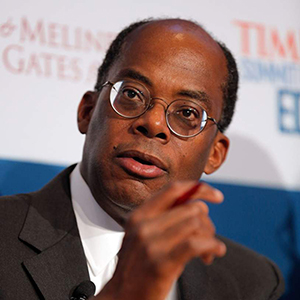The future of work and workers is closely linked to the impact of two demographic tidal waves now re-shaping our society.
Roger W. Ferguson Jr. is president and chief executive officer of TIAA-CREF, the Fortune 100 financial services company, and the former vice chairman of the U.S. Federal Reserve System.

The first is the aging of America, which is happening as lifespans increase and birthrates fall.
Average life expectancy in the United States has hit an all-time high of nearly 79 years, while the birth rate has fallen to about 2.1 births per woman—about half what it was at the height of the Baby Boom.
Aging is not just an American phenomenon. In fact, it’s most stark in Europe and Japan—a country where, according to a recent New York Times article, the sale of adult diapers is already outpacing that of baby diapers. Even many developing nations are rapidly aging. By the end of the century, the United Nations forecasts, about a fifth of the world’s population will be 60 and over—up from nine percent in 1990.
This trend has significant implications for our economy—and for workers. Some fear it will usher in a period of reduced economic growth and innovation. Some are predicting a worldwide retirement crisis, with far-reaching consequences like falling living standards in wealthy countries and frustrated expectations in developing nations.
One implication is clear: Around the globe, there will be fewer workers supporting more retirees. Already in Europe, for every 100 people of prime working age—20 to 64—there are 28 at retirement age—65 and older. That’s nearly twice the world average. The ratio is more like 40 per 100 in Japan.
Public pension systems everywhere are being squeezed. In the U.S., we are seeing the strains on the programs that provide people with financial security in retirement: Social Security, Medicare, and, to some extent, Medicaid. In 1950, there were 16.5 workers for each retiree drawing Social Security benefits. Today, there are about 2.8 workers per retiree, and that is forecast to drop to a two-to-one ratio in the coming decades. The trustees of Social Security say the program will be depleted by 2033 if no action is taken to shore it up.
Governments around the world are making changes to their pension systems—like raising the official retirement age—to make them sustainable. In most of the 30 countries that make up the Organization for Economic Cooperation and Development, the official retirement age will be at least 67 by around 2050. Earlier this year, in the first revision of its retirement policy since the 1950s, China set a timeline to raise its retirement age, although it has yet to announce what that age will be.
Nations are also implementing reforms to increase workers’ retirement savings. Countries as diverse as Australia, Chile, Germany, Poland, Singapore, the United Kingdom, and the U.S. are either encouraging—or requiring—people to save more for their own retirement.
One way to mitigate the effects of fewer workers per retiree is to increase the productivity of our economy. Yet productivity growth in the U.S. has slowed tremendously in recent years. There is much uncertainty about why—and about how to address it.
Calling productivity gains “the wellspring of higher living standards,” Princeton professor Alan Blinder has described the nation’s productivity performance as dismal. He notes that from mid-1995 to the end of 2010, “productivity growth (in the nonfarm business sector) averaged a bountiful 2.6 percent per annum … but only a paltry 0.4 percent since.”
I would argue that one way to reverse course would be to channel technological advances in ways that boost our productivity—not just enhance our leisure time. Don’t get me wrong. I’m not bashing the kinds of innovations that brought us Facebook, Instagram, and texting. But our focus as a society should be on driving technological innovation in ways that make us more productive at work—and speed economic progress for the benefit of all.
How do we get there? That brings me to the second demographic tidal wave reshaping our society: the ascendance of Millennials. This year, the Millennials—at 83.1 million strong—overtook the 75 million Baby Boomers to become the nation’s largest population group. Millennials are now a quarter of all Americans.
As they move into the workforce in large numbers, Millennials have sometimes gotten a bad rap. Questions have been raised about their attitudes toward work, loyalty to employers, and engagement in the workplace—and how all these factors will affect productivity.
It’s true that Millennials often approach work differently than Boomers. Their attitudes have been colored in part by some of the unique challenges they have faced in the wake of the financial crisis, like longer periods of underemployment or unemployment than previous generations. Rising college costs have left them with higher student debt loads.
But as someone who regularly visits college campuses nationwide, I am optimistic. I have seen that Millennials can be every bit as committed and engaged as my generation. They are entrepreneurial and creative. They have a can-do attitude and want to be successful. There is no reason to think Millennials will be any less productive than the Boomers.
In fact, I think they hold the key to finding solutions to the challenges we face as a result of an aging population and declining productivity. No other generation has the comfort and fluency with technology that they do. They are in a unique position to translate technological innovation into productivity gains. And I have every confidence they will do just that.

For the Future of Work, a special project from the Center for Advanced Study in the Behavioral Sciences at Stanford University, business and labor leaders, social scientists, technology visionaries, activists, and journalists weigh in on the most consequential changes in the workplace, and what anxieties and possibilities they might produce.




